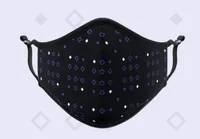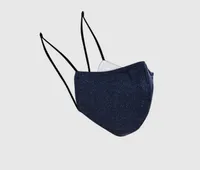We tested the 5 top methods to stop your glasses from fogging up when wearing a face mask – here's what we found
There are plenty of theories for how to stop your glasses fogging up when wearing a face mask... but do they actually work?


There are several theories for how to stop your glasses from fogging up when you're wearing a face mask. If you're a specs wearer who doesn't want to choose between potentially contracting a horrible virus and being able to see, you'll need to find a way to keep your glasses mist-free when you're out and about.
We've put a few methods to the test, to see how effective they are at stopping your glasses from fogging up when you put on your mask. Read on for what we found. And if you haven't yet got hold of a mask, try our guide to the best face masks for a range of situations.
Method #1: Use a face mask with a nose bridge
First up, use a mask that's fitted around the nose. The closer fitting the top of the mask is to your face, the less breath will be making its escape to the space between your eyes and your specs. Some face masks come with mouldable nose pieces (which is where the biggest gaps might be), and others have a flexible wire along the full top edge.
Does it work?
Yes. I tried a Vistaprint mask with an inbuilt nose piece. With this, the glasses misted up just a tiny bit, but not enough to block vision, and the fog cleared within a few seconds.
I also tried a mask with a wire sewn along the entire top edge – like this unisex one from Reiss – that could be moulded to keep it flat against my cheeks as well as my nose. My glasses remained fog-free. Hurrah!
Method #2: Tuck your mask under your glasses
If you've already purchased a face mask and it doesn't have a mouldable nose piece, this might be your second best bet. This method follows a similar theory as the one above: you tuck the face mask under your glasses frame, to make the gaps smaller, stopping air from escaping from the top of your mask.
Does it work?
Yes! With a couple of caveats. When I tried it, I had to sit my glasses a little lower down the bridge of my nose, because in their normal position the mask is too high up and obscures my vision. This method is a little more fiddly than using a mask with an adjustable top, and how effective it is will probably depend on your style of glasses.
Get all the latest news, reviews, deals and buying guides on gorgeous tech, home and active products from the T3 experts
Method #3: Clean your glasses with soap (or shaving foam)
Here's where the tips start getting a little more scientific. The theory is that washing your glasses with soapy water leaves behind a film that reduces the surface tension on the lenses, making the water molecules in your exhaled breath distribute themselves evenly into a transparent layer, rather than clustering together (causing the fog).
To try this method, all your need to do is gently rub a little soapy water across your lenses, rinse it off, shake off the excess water and then dry with a clean cloth or a tissue. Others have used shaving foam, to the same effect.
Does it work?
No. My glasses still steamed up (although they are nice and clean now). This method is backed up by the National Library of Medicine, though – so maybe I'm doing something wrong?
Method #4: Tape the top of your mask up
As with methods #1 and #2, the idea is to stop exhaled air escaping from the top of the glasses. You can use any kind of tape that's not going to take your skin off with it when you remove it (we'd give duct tape a miss).
Does it work?
Probably, but there are more down-sides here: it's not the most comfortable to have tape stuck to your face, and it's going to lose its stick over long periods or if your face is getting sweaty. Plus you're going to look a bit stupid. Still, okay in a pinch.
Method #5: Try an anti-fog spray or wipe
The final technique for how to stop your glasses from misting up when wearing a face mask is to try an anti-fog spray or wipe. These are easy to get hold of and pretty inexpensive. Many are aimed specifically at swimming googles or diving masks, but will work the same way on your glasses.
Does it work?
We haven't been able to try any of these ourselves, but some are extremely well reviewed – for example this Quick Spit Anti-Fog spray has four stars over around 3k reviews on Amazon. Check the reviews for whichever product you're thinking of buying before committing.
Vistaprint face masks | $18 / £17 for one at Vistaprint
Built-in nose piece: Vistaprint makes excellent face masks, with an in-built nose piece you can pinch to fit, and stop air escaping from the top – ideal for glasses-wearers. The design is shaped to fit snugly around the face, too, and there are options for both adults and kids.
Reiss Unisex face mask | £20 for one at Reiss
For an even more custom, close fit around the face, try this face mask from Reiss. It has a wire sewn along the top edge, so you can shape it to your exact facial contours. Excellent for stopping air escaping and fogging your glasses.

Ruth was T3's Outdoors and Wellness Editor from 2020 to 2022, covering hiking, camping and adventure sports kit, as well as mattresses, sleep accessories, yoga and general wellness. She's now a Homes Editor at sister site TechRadar, where she deals in all things air (vacuum cleaners, robovacs, fans and air purifiers), and hair (hair dryers, straighteners and stylers).

